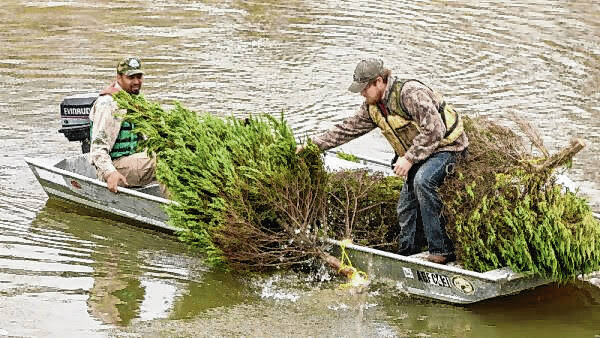Instead of subjecting your Christmas tree to being ground into mulch for suburban landscaping, turn it into important habitat for fish and wildlife. Sinking Christmas trees in lakes and ponds builds valuable fish habitat. If your pile a few together along a fence row or in a field of grass, you are building a home for rabbits, birds reptiles and more. After bringing joy to our homes, we owe Christmas trees the gift of serving conservation as habitat improvements.
When I was a kid, we lived on a lake in a large subdivision. There were close to 2,000 homes, so it was a target rich environment for spent Christmas trees. Each year, for a couple of weeks after Christmas, members of our family would spend our evenings driving around the subdivision with a flatbed trailer behind my uncle’s van, garbage-picking trees from the end of driveways until we couldn’t squeeze another on the trailer. Then we would take them back to his garage, where we’d prepare them for sinking.
There were two ways we’d prepare the trees to be sunk. Most often, we’d work on lashing a dozen or so together into a large wad. Then we’d wrap a chain all the way around them and run it through a couple of cinder blocks. The other way we prepared individual trees was to put the bottom in a small bucket and fill it with concrete. We used a lot of 1-gallon ice cream tubs for the buckets.
Sunken Brush Pile
Sinking brush to attract fish is no secret. A lot of people do it in front of their own docks. But not a lot of people go through the effort to create exceptional habitat around an entire lake. Doing so gives you a great advantage when fishing through the seasons.
A press release issued by the Ohio Department of Natural Resources (ODNR) states, recycled live-cut Christmas trees are used as fish habitat in both public and private waters. Christmas trees are donated to the Division of Wildlife by community recycling and drop-off programs. The trees are bundled together and weighted down so they sink to the bottom, attracting fish and providing cover.
Sunken trees provide structure for many baitfish, which in turn attract sport fish. Decomposing trees also feed zooplankton, which provide food for aquatic invertebrates and attract larger fish. Private pond owners may also want to consider repurposing trees to add habitat to their ponds. Many species are attracted to this dense cover, including crappie, bluegill, and largemouth bass.”
Landscape Brush Piles
When a good snow has covered the landscape, working a good bird dog or a couple of beagles through a field full of brush piles, should produce small game hunting action. Quail and rabbits will hold tight to the cover. When they flush or burst, you’ll feel good knowing you built quality habitat where wildlife can survive and thrive.
The ODNR release also states, a live-cut Christmas tree can also be recycled as the centerpiece of a wildlife-friendly brush pile. Place the tree in a selected location and stack limbs around it in a square arrangement, layering more brush until a desired height is reached.
Cover the top with additional brush to create a unique and valuable shelter for small animals. Songbirds, including cardinals, chickadees, titmice, nuthatches, and wrens travel in and out of brush piles for food, nesting, and to escape predators. Small mammals, such as rabbits and chipmunks, also use brush piles for shelter and raising young. Brush piles are valuable shelter for overwintering insects like bees, moths, and butterflies, as well.
Be sure your Christmas tree is free of all decorations before repurposing as fish or wildlife habitat. Many of these items could be harmful to wildlife, water or habitat if not removed. Also, don’t try to be slick and leave a Christmas tree in the name of habitat anywhere you don’t have permission. If you have permission, you’re building habitat. If you don’t, you’re littering.
See you down the trail…
Brandon Butler writes an outdoors column for The Republic. Send comments to [email protected]. For more Driftwood Outdoors, check out the podcast on www.driftwoodoutdoors.com or anywhere podcasts are streamed.





